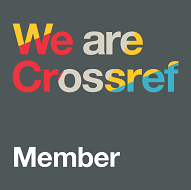Blended Humor and Mind Mapping in Improving 21st Century Skills
Abstract
Instructional communication that occurs in the classroom is expected to be pleasant communication for achieving instructional goals and improving 21st century skills. 21 st Century skills include communication, collaboration, critical thinking, and creativity. This study aims to enhance students’ 21st century skills through the application of humor and mind mapping in classroom instructional activities. The object in this study was the 65 freshman in the Professional Education Department of Universitas Indraprasta PGRI. The method used in this research was descriptive qualitative. The results show that learning in the classroom becomes more fun and stress free to understand through humor applied through humorous, motivating, and ice breaking videos. Besides, there are communications between students through discussion forums and collaboration between them in the learning process. Other than that, student cognitive in critical thinking about the problems discussed in the learning material improves, as well as their creativity in organizing learning media digitally and non digitally.
Keywords
Full Text:
PDFReferences
Adnyana, I. M. D. S., & PF, K. A. P. D. (2019). Implikasi keterampilan abad 21 pada proses pendidikan agama hindu. Journal of Chemical Information and Modeling, 53(9), 1689–1699. https://doi.org/https://doi.org/10.1017/CBO9781107415324.004
Anggraeni, A. D. (2018). Metode role playing dalam pembelajaran profesi kependidikan. Jurnal Pendidikan Progresif, 8(1), 29–35. https://doi.org/https://doi.org/10.23960/jpp.v8.i1.201804
Anggraeni, A. D., & Pentury, H. J. (2018). Using graphic organizer as a media in students’ writing project. Scope: Journal of English Language Teaching, 2(02), 105–111. https://doi.org/https://doi.org/10.30998/ scope.v2i02.2307
Astuti, T, P. (2019). Model problem based learning dengan mind mapping dalam pembelajaran IPA abad 21. Proceeding of Biology Education, 3(1), 64–73. https://doi.org/https://doi.org/10.21009/pbe.3-1.9.
Elmunsyah, H., Hidayat, W. N., & Asfani, K. (2019). Interactive learning media innovation: utilization of augmented reality and pop-up book to improve user’s learning autonomy. Journal of Physics: Conference Series, 1193(1), 12031.
Gunawan, I. (2013). Metode penelitian kualitatif (Vol. 143). Bumi aksara.
Hidayah, Y. F., Siswandari, S., & Sudiyanto, S. (2018). Pengembangan media komik digital akuntansi pada materi menyusun laporan rekonsiliasi bank untuk siswa smk. Jurnal Pendidikan Dan Kebudayaan, 2(2), 239–250. https://doi.org/https://doi.org/10.24832/jpnk.v2i2.588
Khsaniatun, N., Sholeh, K., & Faizah, U. (2014). Implementasi model mind mapping (peta pikiran) dalam pembelajaran menulis teks anekdot pada siswa kelas x Smk Pariwisata Dalung. Jurnal Pendidikan Dan Pembelajaran Bahasa Indonesia, 3(1).
Kurniawan, H. R., Elmunsyah, H., & Muladi, M. (2018). Perbandingan penerapan model pembelajaran project based learning (PJBL) dan think pair share (TPS) berbantuan modul ajar terhadap kemandirian dan hasil belajar rancang bangun jaringan. JP (Jurnal Pendidikan): Teori Dan Praktik, 3(2), 80–85.
Mariyan, N. W. I., Marhaeni, A. A. I. N., & Sutama, M. (2013). Pengaruh implementasi strategi mind mapping terhadap prestasi belajar menulis kreatif ditinjau dari kreativitas siswa (Vol. 3, Issue 2, pp. 1–10). Ganesha University of Education.
Muhlisin, A., & Kunci, K. (2017). Inovasi model pembelajaran RMS untuk meningkatkan kecakapan abad 21. Seminar Nasional Hayati V, 27–36.
Musyafa, M, I. (2017). Hubungan antara efikasi diri dengan kecemasan komunikasi dalam bersiaran pada penyiar radio Kota Malang. Universitas Islam Negeri Maulana Malik Ibrahim.
Putro, S. C., Elmunsyah, H., Putranto, H., & Nidhom, A. M. (2017). Pengaruh aspek sosial psikologis terhadap kesiapan menjadi guru SMK di jurusan TE FT um. Teknologi Dan Kejuruan: Jurnal Teknologi, Kejuruan, Dan Pengajarannya, 40(1), 59–68.
Setyarini, D. (2019). Metode pembelajaran mind map untuk meningkatkan prestasi belajar anak didik sekolah dasar. Jurnal Ilmiah Pendidikan Dasar, 6(1), 30–44. https://doi.org/DOI: http://dx.doi.org/10.30659/pendas.6.1.30-44
Smith, E. R., & DeCoster, J. (2000). Dual-process models in social and cognitive psychology: Conceptual integration and links to underlying memory systems. Personality and Social Psychology Review, 4(2), 108–131.
Sugiyono, P, D. (2017). Metode penelitian bisnis: Pendekatan kuantitatif, kualitatif, kombinasi, dan R&D. Alfabeta.
Tasiam, F. J., Kustono, D., & Elmunsyah, H. (2017). The competence readiness of the electrical engineering vocational high school teachers in Manado towards the ASEAN economic community blueprint in 2025. Journal of Education and Learning, 11(3), 337–342.
DOI: http://dx.doi.org/10.17977/um048v25i1p1-5
Refbacks
- There are currently no refbacks.
Copyright (c) 2020 Jurnal Ilmu Pendidikan

This work is licensed under a Creative Commons Attribution 4.0 International License.
| Jurnal Ilmu Pendidikan |
![]() Jurnal Ilmu Pendidikan is licensed under a Creative Commons Attribution 4.0 International License.
Jurnal Ilmu Pendidikan is licensed under a Creative Commons Attribution 4.0 International License.

2.png)
1.png)
1.png)
1.png)
1.png)
4.png)
.png)
1.png)
.png)
.png)


3.png)
1.png)
1.png)


